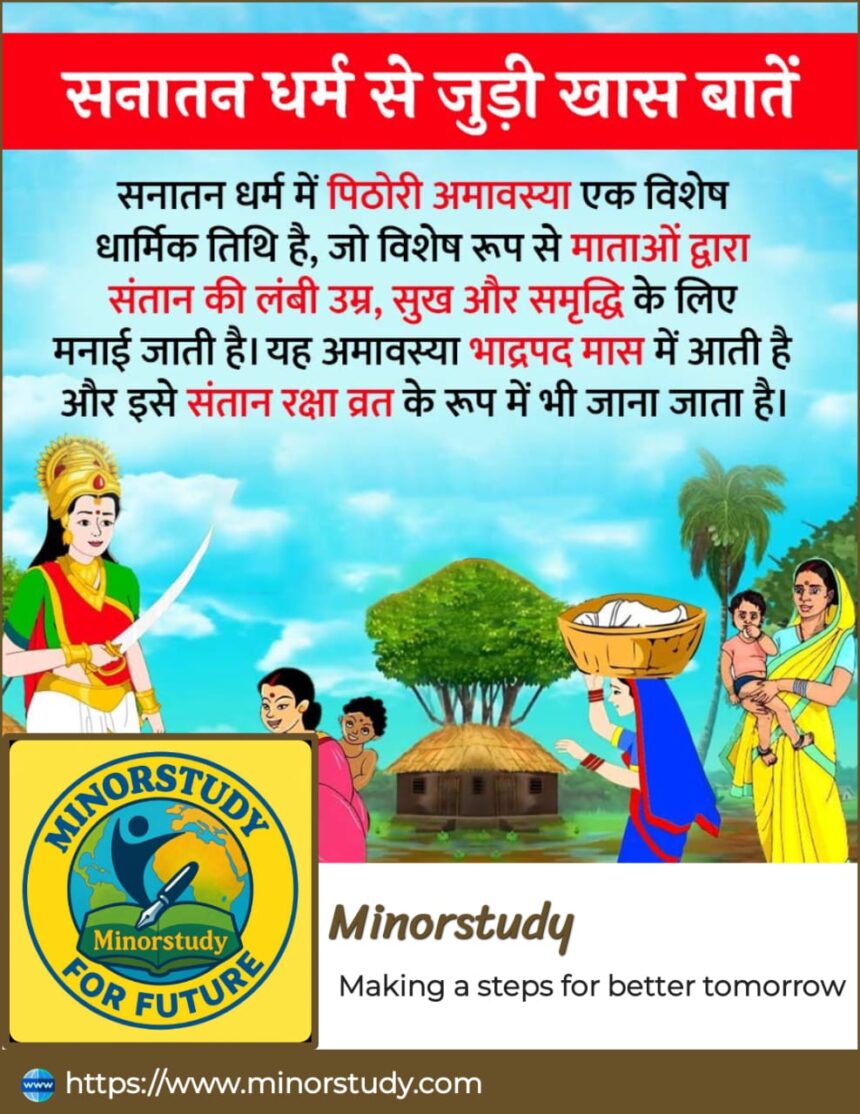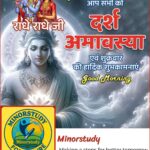🌿 Introduction
Sanatan Dharma is filled with sacred observances that celebrate life, family, and spiritual well-being. Among them, Pithori Amavasya holds a unique place. Celebrated in the month of Bhadrapada (August–September), this special Amavasya is dedicated to the welfare of children.
- 🌿 Introduction
- 📖 History of Pithori Amavasya
- 🌟 Key Facts About Pithori Amavasya
- 📅 Timeline of Pithori Amavasya
- 🧭 Significance of Pithori Amavasya
- 🙏 Observance and Rituals
- 🌟 Wishing on Pithori Amavasya
- ⭐ Important Points to Remember
- 🧩 Impact on Daily Life
- 📢 FAQs About Pithori Amavasya
- 📝 Review Section
- 🎯 Conclusion
Mothers observe this day with deep devotion, performing rituals and fasting to seek long life, health, happiness, and prosperity for their children. It is also called Santan Raksha Vrat, highlighting its focus on protecting offspring. The observance reflects the eternal values of Sanatan Dharma, where motherhood is revered as divine and children are considered blessings of God.
This article explores the history, facts, rituals, timeline, FAQs, significance, observance practices, impact on daily life, wishing, and reviews of Pithori Amavasya in a human-friendly way.
📖 History of Pithori Amavasya
Vedic Tradition: The roots of Pithori Amavasya can be traced back to the Vedic period when women performed fasts and yajnas for family prosperity and the well-being of their children.
Purana References: In Skanda Purana and other scriptures, the significance of Amavasya days is described as highly auspicious for appeasing deities and ensuring the welfare of the family.
Cultural Evolution: Over time, the observance took the form of Pithori Vrat, where mothers worship goddess Durga and sixty-four Yoginis for the protection of their children.
Name Origin: The word Pithori is believed to come from Pitha (flour). Traditionally, mothers make idols of 64 Yoginis from flour and worship them for blessings.
🌟 Key Facts About Pithori Amavasya
Observed on Amavasya of Bhadrapada month (as per Hindu lunar calendar).
Also called Santan Raksha Vrat, dedicated to child welfare.
Worship involves 64 Yoginis who protect children.
Mothers prepare flour idols and offer prayers.
It emphasizes family bonding and gratitude.
Fasting is done by women for their children’s health.
Associated with Durga worship and divine motherly energy.
Strongly practiced in North India, especially in Uttar Pradesh, Madhya Pradesh, Rajasthan, and Bihar.
In some regions, milk, rice, and sweets are offered during rituals.
It combines ancestral reverence and child protection.
Strengthens the role of motherhood in Sanatan Dharma.
📅 Timeline of Pithori Amavasya
Ancient Vedic Era (~1500 BCE): Rituals for family welfare begin.
Puranic Period (~500 CE): Amavasya linked with goddess worship and Pitru rituals.
Medieval India: Flour idols of Yoginis become a part of rural household traditions.
Modern Times: Observed as a devotional vrat by mothers across India.
🧭 Significance of Pithori Amavasya
Mother’s Devotion: Symbolizes the unconditional love and sacrifice of mothers for their children.
Child Protection: The rituals and prayers are focused on ensuring long life and prosperity for children.
Ancestral Reverence: By observing Amavasya, families remember and honor their ancestors.
Spiritual Cleansing: The fast purifies the body and mind, aligning the devotee with divine energy.
Social Harmony: Reinforces family bonds, unity, and cultural traditions of Sanatan Dharma.
🙏 Observance and Rituals
🌞 Morning Rituals
Devotees wake up early, bathe, and clean the house.
A sacred space is prepared with idols made from flour (pitha).
🕉 Worship of 64 Yoginis
Idols of 64 Yoginis are made using wheat flour or clay.
Offerings of milk, rice, fruits, and sweets are made.
Special prayers are recited for child welfare.
🌸 Fasting and Charity
Mothers keep a fast, taking only fruits or milk.
In the evening, after puja, the fast is broken.
Food and gifts are offered to Brahmins and needy children.
🪔 Evening Prayers
Diyas (lamps) are lit, symbolizing removal of darkness.
Mothers pray to Goddess Durga and the Yoginis for their children’s well-being.
🌟 Wishing on Pithori Amavasya
Sample Wishing Message:
“On this Pithori Amavasya, may Goddess Durga bless your children with health, happiness, and a long life filled with success and prosperity.”
Other wishes:
“Happy Pithori Amavasya! May this sacred vrat bring endless blessings to your family.”
“May your children always be healthy and successful with the grace of the Divine Mother.”
⭐ Important Points to Remember
Pithori Amavasya is observed mainly by mothers.
Worship involves 64 Yoginis for protection of children.
Fasting is symbolic of sacrifice and devotion.
It reflects the Sanatan Dharma values of family, faith, and gratitude.
Performing charity on this day is highly meritorious.
🧩 Impact on Daily Life
Strengthens Family Bonds: Mothers’ devotion inspires unity in families.
Cultural Preservation: Keeps alive age-old Sanatan Dharma traditions.
Emotional Security: Gives mothers confidence that divine blessings protect their children.
Moral Teaching for Children: Kids learn the values of respect and gratitude towards parents.
Spiritual Growth: Fasting and prayers bring inner peace and positivity.
📢 FAQs About Pithori Amavasya
Q1. What is Pithori Amavasya?
It is a religious observance in Sanatan Dharma, celebrated by mothers for the long life and prosperity of their children.
Q2. When is it observed?
On the Amavasya Tithi of Bhadrapada month (August–September).
Q3. Who are worshipped on this day?
Goddess Durga and the 64 Yoginis.
Q4. Why is it called Santan Raksha Vrat?
Because it is observed for the protection (raksha) and welfare of children (santan).
Q5. What rituals are important?
Fasting, making flour idols, offering prayers, lighting lamps, and charity.
📝 Review Section
✅ Positive Reviews (Devotees Say)
“This vrat gives me inner strength as a mother to protect my children.”
“I feel blessed and spiritually connected on Pithori Amavasya.”
“It is a festival of motherhood and love, reminding us of divine blessings.”
⚠️ Critical Reviews (Skeptics Say)
“Some may see flour idol worship as symbolic rather than practical.”
“Urban lifestyles make it difficult to perform traditional rituals fully.”
⭐ Balanced Review
Pithori Amavasya is a beautiful blend of devotion, tradition, and spirituality. While skeptics may question some symbolic rituals, the day is highly meaningful for mothers who draw emotional, spiritual, and cultural strength from its observance.
🎯 Conclusion
Pithori Amavasya is more than just a ritual date in Sanatan Dharma — it is a celebration of motherhood, devotion, and blessings for children. By fasting, worshipping, and performing charity, mothers express their love in the most selfless way.
This Amavasya reinforces the eternal values of faith, family, and gratitude. In today’s modern world, where people are often distanced from traditions, such observances serve as a reminder of the divine connection between parents, children, and society.
✨ Final Thought: Pithori Amavasya is a festival of love and protection — proving once again that in Sanatan Dharma, family and faith are the greatest treasures of life.








